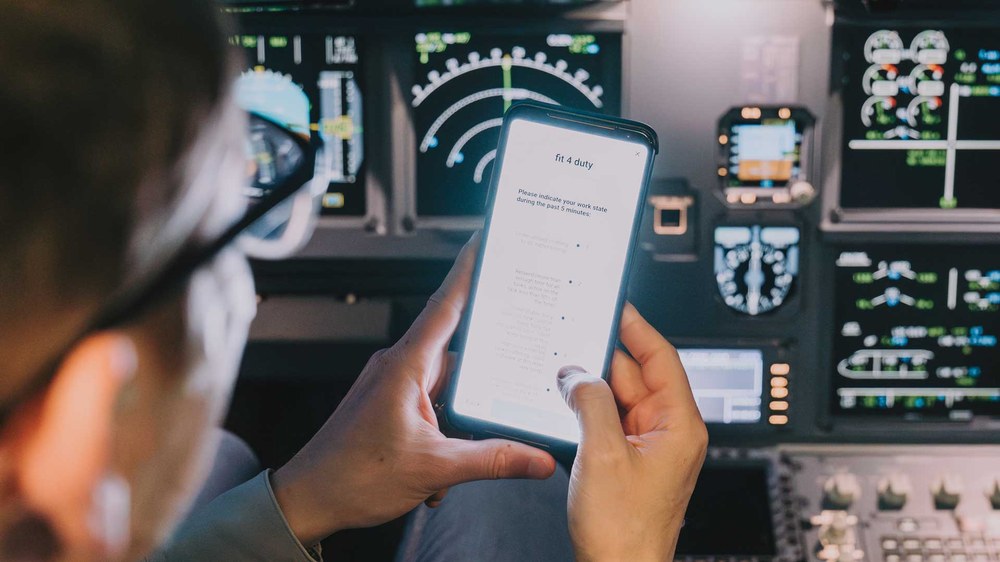How effective are today's working-time rules for flight crews?

© Fraunhofer IDMT / Leona Hofmann
- In a Europe-wide study into current time duties and requirements for aircrew, DLR's Fit4Duty app enabled detailed data collection and direct communication with participants throughout.
- DLR was responsible for extensive data processing and analysed the optimal flight duty time for crew members suffering from jet lag.
- The project filled in fundamental research gaps concerning controlled rest and on-call duty.
- The findings show that current flight duty time restrictions are largely effective in managing fatigue risks.
- Focus: Aviation, medicine, flight safety
Fatigue impairs attention and decision-making among aircrew and poses a safety risk in aviation. To prevent incidents, regulations limiting flight duty periods and establishing minimum rest periods have been introduced by authorities such as the European Union Aviation Safety Agency (EASA). The German Aerospace Center (Deutsches Zentrum für Luft- und Raumfahrt; DLR) has participated in a Europe-wide study conducted on behalf of the EASA to assess the effectiveness of current flight duty time limits. The study examined whether current regulations provide sufficient protection against excessive fatigue among crew members and how the understanding of fatigue risks in commercial aviation can be improved.
Using surveys, interviews and the collection of large-scale field data, researchers monitored more than 220 flight and cabin crew members from eight European airlines while on duty over several weeks. They measured fatigue, cognitive performance, sleep and workload. The study found that existing duty time restrictions are largely effective in managing fatigue risks, and that duty length, time of day of duty, prior sleep duration and total time awake have the strongest impact on fatigue. Crew role (flight deck or cabin), and individual factors such as age and sex, also play a part. The study confirms that 'controlled rest' – the opportunity for pilots to take carefully managed short naps in their cockpit seats – is also effective in managing fatigue, especially before critical phases of flight.
Detailed data collection via DLR's Fit4Duty app
Developed by the Sleep and Human Factors department at the DLR Institute of Aerospace Medicine, the Fit4Duty app enabled large-scale data collection for the study. Data gathered included reliable measurements of cognitive performance, detailed descriptions of flight duties and real-time monitoring and repeat recording of fatigue, workload and rest breaks. The app also enabled direct communication with participants during the study. DLR was responsible for the extensive data processing and focussed in particular on how long jet-lagged flight crew members can safely remain on duty.
"The scope of this field study makes it a landmark on the path to continually improving aviation safety," says Daniel Aeschbach, Head of DLR's Sleep and Human Factors department. The findings from the study served as the basis for further recommendations to the EASA, including extending current requirements for appropriate fatigue risk management to all flight duty periods of ten hours or more. The researchers also concluded that the existing 18-hour limit on awake time for on-call duties leading to a flight assignment can remain, but additional measures should be taken to maximise sleep opportunities for crew before long shifts. Up until now, controlled rest has been permitted for pilots as a way of coping with unexpected fatigue, but the study recommends that pilots are permitted to use controlled rest periods preventively – in other words to prevent expected fatigue, such as on long night flights.
The project consortium was led by the Netherlands Aerospace Centre (NLR), with partners DLR, the Finnish Institute of Occupational Health, Stockholm University and Jeppesen. The project closed fundamental research gaps in controlled rest and on-call duty and provided a unique scientific assessment with a bearing on future EU legislation. DLR made a significant contribution to the implementation and success of the project by providing an app specifically developed for field data collection.
